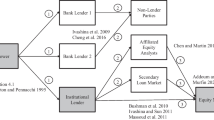Abstract
This paper studies how participation exemption (PEX) tax rules for stocks owned by companies, which are frequent in EU countries, introduce tax arbitrage opportunities. The focus is on Italy’s PEX rules. PEX enables companies to make manufactured loans that generate tax exempt interest income by combining stocks with forwards or options. Borrowing through similar manufactured loans allows companies to bypass restrictions to deducting the cost of borrowing. PEX induced arbitrage exploitable through stock and options portfolios is available even when put-call parity holds for European options. Derivatives that hedge a stock can “inherit” the PEX regime of the stock they hedge. PEX gives companies that own a stock a tax timing option, which can be exploited through stock straddle strategies, i.e. long-short positions in the same stock, and which can generate valuable tax savings.
Similar content being viewed by others
References
Collins, J. H., & Kemsley, D. (2000). Capital gains and dividend taxes in firm valuation: Evidence of triple taxation. Accounting Review, 75(4), 405–427.
Constantinides, G. (1983). Capital market equilibrium with personal tax. Econometrica, 51, 611–636.
Constantinides, G. (1984). Optimal stock trading with personal taxes: Implications for pricing and abnormal January returns. Journal of Financial Economics, 13, 65–89.
Constantinides, G., & Ingersoll, J. (1984). Optimal bond trading with personal taxes: Implications for bond prices and estimated tax brackets and yield curves. Journal of Financial Economics, 13, 299–335.
Dammon, R., Dunn, K., & Spatt, C. (1989). A reexamination of the value of tax options. Review of Financial Studies, 2, 341–372.
Dammon, R., & Spatt, C. (1996). The optimal trading and pricing of securities with asymmetric capital gains taxes and transaction costs. Review of Financial Studies, 9, 921–952.
Liu, S., Qi, H., & Wu, C. (2006). Personal taxes, endogenous default, and corporate bond yield spreads. Management Science, 52, 939–954.
Liu, S., Shi, J., Wang, J., & Wu, C. (2007). How much of the corporate bond spread is due to personal taxes? Journal of Financial Economics, 85, 599–636.
Liu, S., & Wu, C. (2004). Taxes, default risk and credit spreads. Journal of Fixed Income, 14, 71–85.
Scholes, M. (1976). Taxes and the pricing of options. Journal of Finance, 31(2), 319–332.
Scholes, M., & Constantinides, G. (1980). Optimal liquidation of assets in the presence of personal taxes: Implications for asset pricing. Journal of Finance, 35(2), 439–449.
Author information
Authors and Affiliations
Corresponding author
Appendix: the present value of the arbitrage profit as per strategy B
Appendix: the present value of the arbitrage profit as per strategy B
We notice that under the assumptions of Eqs. 13 and 15, and again assuming that \( S_{T} \simeq S_{{T^{ - } }} \) and \( T \simeq T^{ - } , \) and under the assumptions of Eqs. 12 and 14, the time t present value of \( \tau \cdot \max \left( {S_{{T^{ - } }} - S_{t} ,0} \right), \) i.e. the arbitrage profit as per strategy B in the text, is
with \( N(x) = \int_{ - \infty }^{x} {{\tfrac{1}{{\sqrt {2\pi } }}}e^{{ - {\tfrac{{u^{2} }}{2}}}} du} . \)
Rights and permissions
About this article
Cite this article
Realdon, M. Participation exemption and tax arbitrage: Italy’s case. Eur J Law Econ 36, 77–93 (2013). https://doi.org/10.1007/s10657-010-9207-6
Published:
Issue Date:
DOI: https://doi.org/10.1007/s10657-010-9207-6




